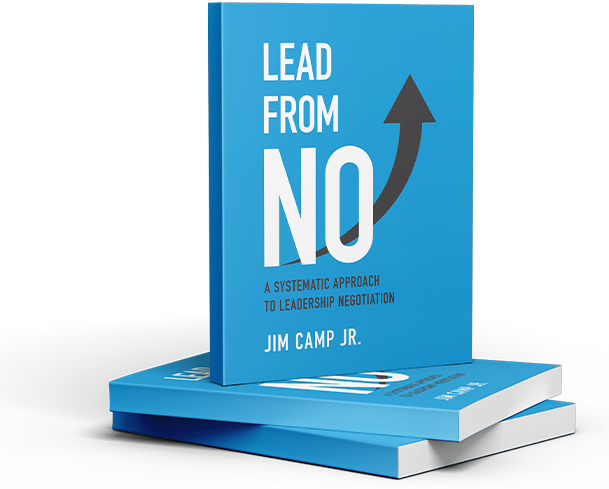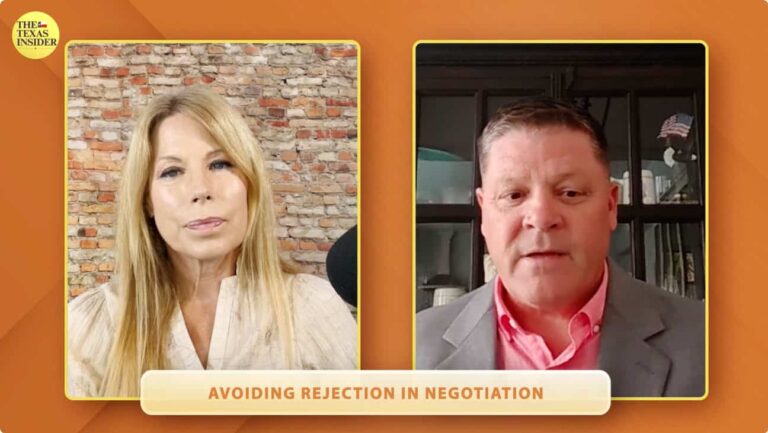Intro to Video: An agent comes from another agency and wants to keep the same rates. Should we try to match his rates?
This is Part 4 of the transcript from Dave DeSantis’ webinar for GreenWave Commissions CEO Slava Isayev. (If you missed Part 3, listen here.)
Slava Isayev: Dave, if you could help us now that you set the groundwork, or so to say, foundation for everybody from which we can build, how do we respond to reps who want to bring their own compensation plan to our company and negotiate that process?
Dave DeSantis: Okay. Great. So let me just introduce another topic for you when you hear that question. And it’s a thing we call your Negotiation Purpose. Okay. Whenever you’re going to go into a negotiation, you should have a firm Negotiation Purpose and a Negotiation Purpose Statement, which is what you communicate to the other side.
So your Negotiation Purpose is to solve the real problem of the other party under conditions that make sense to you. If you’re able to do that, if you’re able to solve their problem under conditions that make sense to you, that’s a successful negotiation. So you solve their problem, but you got what you wanted under the conditions that make sense to you.
Okay. So that’s the first thing, to have a definition of success. That’s also telling you that look, “If I’m going into a negotiation, I’m not just going to make this up as I go along.” If my definition of success is that I have to solve their problem under conditions that make sense to me, it’s telling me I can’t even begin to do anything or make any offers until I understand their problem.
Slava: Like in this case, for example, why is the agent leaving the other agency?
Dave: There you go. That’s a potential. So when you’re getting thrown into a negotiation; What do you want to do? Five or 10? What do you want to do? Yes or no? The first thing you do is step back, “What problem am I solving, and who am I solving it for?”
The answer is, I don’t know. Maybe five is a good answer. Maybe 10 is a good answer. It depends on the situation. It depends on the problem I’m solving. It depends on the conditions that make sense to me.
So the first thing you want to do is come up with your Negotiation Purpose. And if you don’t understand what the real problem is, then you know what your Negotiation Purpose is. It’s to find that problem. So you cannot make any offers, no successful agreement is ever concluded unless there is a pain that is being solved or some kind of compensation or trade on the other side.
So if you have that as a basis for a good agreement, it has to be solving the pain of one party for some compensation for the other. Okay. That compensation could take the form of money, or it could take the form of, “Hey, I’ll solve your pain. And if you solve my pain, maybe there’s no money, but there’s a trade there going on.”
If you’re in the process of negotiation, you wanna know what that trade is or potentially could be. And the only way you could really start is by understanding the pain or the problem of the other side.
So we’re gonna go into this negotiation now, and you’re hiring a new rep. So you’re thinking to yourself, my problem is I just had a rep that left, or my agency is expanding.
I need more bodies to make more phone calls, bring more, and book more business so I can grow. So my pain is growth. My pain is getting efficient producers, as opposed to those I’m paying a fixed salary to that aren’t producing. Okay. Guess what? I just spent all the time talking about my problem. All right. I gotta get in the head of the other person.
Why is that other person coming to me and even interviewing for the job? Okay. So Slava, you said it. Why are you leaving your old place? What is the reason? I don’t know. Did they get fired? Did they get capped at their income potential? Are they going in a different direction? I don’t know. I’m not an insurance guy. Are they good at telling auto policies, and you’re focused on home and life? I don’t know. There’s a reason.
So before you’re ready to talk about your deal with them, the compensation plan to bring them on, it behooves you to figure out why they’re even talking to you.
Because really what you’re trying to do is understand those reasons why they’re talking to you, which is going to define their pain, then you’re gonna say, okay, let’s prioritize those pains.
Are you leaving because they told you they’re shutting the agency down in three months, and you’re out of a job? Or are you leaving because you have a higher growth opportunity here, or you’re relocating, or whatever.
And if you find that as the primary reason, that’s the thing that they’re going to value the most. Solving that problem.
So again, let’s circle back. So the guy comes to me and says, “Hey, I wanna get the same compensation program I had the last time because I understand it. It’s easy for me. And that’s it.”
When you told me that, I said, how does that stack on his priorities of pains he’s trying to solve, or she’s trying to solve, or they’re trying to solve?
And if it’s low down the list, probably don’t even have to worry about it.
So to think that you have to come up with an answer for everything. Remember, negotiation is the effort to create agreements between two or more parties, with all parties having the right to veto. That includes you.
So if they’re coming to you with, “My 10th priority problem is a compensation program that mirrors the company that’s going out of business because they pay people too much money.”
You absolutely have the right to veto to say, ” I’d love to be able to help you. It’s not that I don’t want to – that just doesn’t fit within our model.
So what’s more important to you? Satisfying your relocation needs, coming to a company that’s stable and has growth prospects, or getting a compensation program for a company that’s no longer going to be in business.”
And what you’re doing is asking them to make the choice. Do you want to give up your relo opportunity, or do you want to give up your growth opportunity for something that doesn’t exist anymore anyway? So you’re getting them to make the decision against themselves versus you making a decision to compromise your conditions of satisfaction.
Brian Durkin: That’s some heavy stuff right there.
Dave: I apologize for, in 15 minutes, laying it on you like that, but what I’m trying to do is give you a flavor of the thought process. And if you noticed, it’s all from their perspective; what is their pain?
Is it relo? Is it move to a growth company? Is it – was fired. I need a job. It has nothing to do with you. And as humans, we wanna promote our own agenda as opposed to listening to what the other’s agenda is.
Brian: So I have a question along those lines, and I’d like to expand it because I’ve heard the difference between “I understand” and “I hear” as a potential leveraging point. Understanding puts you in a different position than hearing. Where should they start if they’re gonna start asking those questions about their statement of purpose? What are some things they can ask to help establish those rules and those boundaries?
Dave: Yeah. It’s super difficult. You ready? So you’re meeting this person, “Tell me why you’re here?”
Brian: Oh, there you go. Really? That’s it.
Dave: There are many, but I wanted just to demonstrate that it’s not about you telling, selling your agency. ” Why are you here? How can I help you?” You wanna get into their head. ” What brings you from your other agency? You’re a successful guy. I’m looking at your resume and all that. How can we help you do more? What are you looking for?”
Brian: That’s worth the price of admission right there, everybody.
Slava: Just a slight tangent here. My thought on this is the reason why we don’t do it on a regular basis everywhere in our life is I think because we became so transactional in everything that we do. And because of that, we fall into the pattern of negotiating over price instead of trying to understand how to help the other side.
Dave: From a negotiation point of view, what’s behind that? And thank you for saying that, Slava, right? We default the price instead of figuring out what’s really behind why the other person is there. When you can identify why the other person is there, you can do what we call “build a vision for them.”
You can help them realize why they’re talking to you in the first place. They’re talking to you because they wanna relocate. They’re talking to you because they wanted to go into growth. So if you paint the vision for them about growth, they then make the emotional decision, “I wanna work there.”
Now they’re just gonna figure out the details of what has to happen. What’s the salary? What’s the comp?
An analogy would be you’re buying a house. Okay. So you walk into a house, and it hits everything that you’re looking for. It has the right number of bedrooms. The layout is perfect. It’s exactly what you want. It’s in a neighborhood. If schools are important to you, it’s two blocks from the elementary school.
You don’t even know the price yet. Or the terms of the deal, the price, or the offer price, at least because that’s the way real estate works. But you walk into that house, and you love that house, and you say, I want this house.
So what you’ve done there is you’ve made the emotional decision that I want this, and now you’re looking for excuses to buy it. But It’s 10,000 over my budget. I can cut back on something else because I’ve made the emotional decision to buy. Versus if you walk into a house, oh man, this room is painted orange, and I don’t like orange, and it just clouds your feeling about the whole house.
Now your emotional decision is – I don’t like this house. And even if that house is exactly within your budget, you’re going to look for reasons not to buy the house because your emotional decision is either positive or negative.
This is the mistake most salespeople make when they lead with, “Let me tell you about our stuff. Let me show you our price. Let me show you all the data on why it makes logical sense to buy our stuff. If you do that before you give someone the opportunity to make the emotional decision that I like you, and I wanna buy your stuff, every bit of logic you offer is gonna become an objection.
And it’s only because you short-circuited the way people make decisions: they first make them emotionally. Then sometimes, they’re supported with logic. But if you bring in logic before the emotion, all you’re gonna do is create objections. Or you’re much more likely, to put it that way.
Brian: Now, is that a negotiations tactic or is that a sales tactic or is it both?
Dave: It’s negotiation. What is negotiation? You’re either asking for decisions, or you’re communicating decisions.
Brian: Fantastic.
Dave: So if I’m in negotiation, I’m gonna ask that prospect to accept my offer of using my compensation program, not his from his old company. I’m gonna be asking him for a decision. So I want him to make the emotional decision that, yeah, we’re a growth prospect company that’s in his geography where he wants to work or whatever. So emotionally, he’s geared to come with us.
Then it’s much easier for him to relax his other constraint, which is, “Oh, I want the comp plan to look exactly like the old one.”
Okay, now does that mean, “Wait a minute – my old comp plan paid me a lot more?”
That’s a different pain. One is structural. One is absolute dollars, right? But now your decision is: If I really want you and you think he’s worth the value… What if I give you the same amount of money, but just in a different form? So now you can have your compensation plan aligned with what you want, but he gets something close to the money that he wanted.
But you can’t do that until you understand their pain. Is the pain that he really wants the same comp plan, or does he really want the same money? And you only figure that out after you determine what’s the most important thing to him? Is it getting a new job? Is it working with a growing company versus a flat company? So all of these things are prioritized, right?
You wanna solve the biggest problems first and then work your way down into the other ones. Okay. And now maybe the comp is the third-level problem. And now it’s easier for you to find a solution because you’re asking him to trade off, “Hey, is our solution to your third priority problem worth it to you to give up solving your primary two problems?”
That’s a symmetric trade, right? And that’s the process of building the vision for him to make it easy for him to make that decision.





